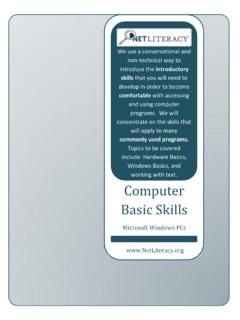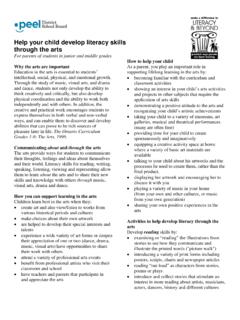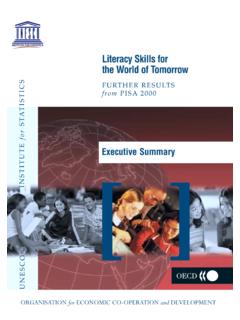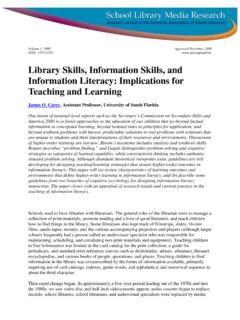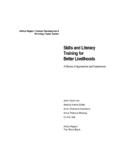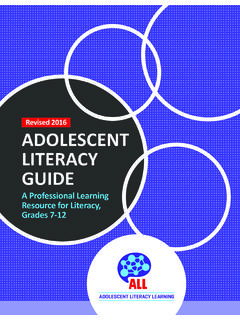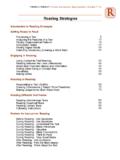Transcription of Computer Basic Skills - Net Literacy
1 Computer Basic Skills Microsoft Windows PCs We use a conversational and non-technical way to introduce the introductory Skills that you will need to develop in order to become comfortable with accessing and using Computer programs. We will concentrate on the Skills that will apply to many commonly used programs. Topics to be covered include: Hardware basics , Windows basics , and working with text. | [Pick the date] 1 P a g e | 1 Basic Computer Components Computers come in different shapes and siz es. However, there are several parts on a Computer that are univ ersal to all computers.
2 Hardware vs. Software Hardware includes the parts of the Computer system that you actually can touch (like the keyboard, mouse, monitor, or CPU). What s a CPU? It s explained below. Software refers to the programs that you use on your Computer (like a word-processing program) or the programs that make your Computer work (you physically cannot touch these). Programs are also called applications. CPU (Central Processing Unit): This box is the brain of a Computer system. It processes, stores, and communicates information. Wires connect your CPU to your monitor and other devices.
3 Computers are somewhat similar to people. They have memories just like us. The memory on a Computer is stored in data on disks. Disks look like small heavy old style records. Disks function similarly like records. As the disk spins inside the Computer , the data on the disk is accessed. The programs that you use (such as word-processing) and the program that runs your Computer (the operating system) are stored on the CPU s hard disk. Monitor: This part of the Computer system that visually communicates with the user. It is somewhat like a television. Almost all information communicated from the Computer to the user is through the monitor.
4 (The monitor is also referred to as the screen ) | [Pick the date] 2 P a g e | 2 On most Computer systems, both the CPU and the monitor have a power switch that turns them on and off. Most power switches have this symbol. Printer: This device takes information (usually text and pictures) from the Computer and prints it on paper. Keyboard: The keyboard is an important tool that allows a user to communicate with the Computer . It is composed of keys that send a signal to the Computer that the Computer recognizes and uses to carry out processes and programs. Keyboards come in various shapes and sizes, but serve generally the same purpose.
5 We ll go over the specific keys in another part of this guide. Mouse: Similar to the keyboard, the mouse is used to communicate with the Computer . The mouse is like a remote control to a TV It is a tool that drives the Computer that can be used away from the Computer ; though the mouse is considered your direct connection into the Computer world. We ll go over how to use the mouse later in the guide. | [Pick the date] 3 P a g e | 3 Welcome to the Computer The first thing to understand is that it s difficult to break a Computer . They are designed to recover from most things a user does to them with a few clicks.
6 If you experience a problem that you can t fix, you can: Ignore the problem Just turn off the Computer until you can get help MANY NEW COMPUTERS USERS ARE MORE CONCERNED ABOUT BREAKING THEIR Computer THAN IS WARRANTED. So relax! Computers come in many different shapes, sizes, colors, and speeds, but all essentially perform the same tasks. Most computers and mice are very similar; but sometimes a Computer might have an extra button or two. While working with computers requires some flexibility and adaptation to different Computer designs, you will find this easy to learn.
7 Also, within a Computer , there are many ways to do the same task. Lastly, the important hint to keep in mind when you re using a Computer is to be patient. Sometimes the Computer has to think too! Keyboard and Mouse The keyboard and mouse are the two most common ways that users communicate with a Computer or tell the Computer what they want it to do. First, we ll look at a keyboard and show you that it s somewhat like a typewriter that has some fancy tools to help you more effectively | [Pick the date] 4 P a g e | 4 communicate with the Computer . A mouse is a little bit like a television remote and also helps you tell the Computer what to do.
8 Keys on the Keyboard Caps Lock Key The caps lock key activates a feature that affects only the letter keys. Pressing on the caps lock button causes all letter keys to type in uppercase. All other keys will act the same as if caps lock is off. To deactivate caps lock, press the caps lock key again. Shift Key The shift key is used in combination with a second key. The shift key is used primarily to capitalize letters. Shift differs from caps lock because you have to hold the shift key down while simultaneously pressing another key to capitalize a letter, where you only press the caps lock key once.
9 Holding down the shift key also is used to type the characters and symbols above the numbers on the number keys. Tab Key The tab key is used to move from one position on the screen to another. It also creates a tab stop (right 1/2 inch) indentation for your paragraphs. This is very similar to a typewriter. Enter Key When working with text (words), pressing on the enter key moves the cursor down to the next line. Otherwise, pressing the enter key will activate anything that you have selected. Escape Key The escape key is used to cancel the current operation or can be used to exit a program.
10 Space Bar Pressing the space bar while the cursor is positioned within text will cause a space (one character wide) to be placed at the position of the cursor (like on a typewriter). | [Pick the date] 5 P a g e | 5 Control Key The control key (Ctrl) is usually used with another key. Holding the control key in addition to another key or keys will start a function. Later on, we will teach you some control key functions that deal with word processing. Alt Key The alternate key (Alt), similar to the control key, and is used in combination with other keys. Arrow Keys The four arrow keys are located on several keys to the right of the spacebar at the bottom of the keyboard.
